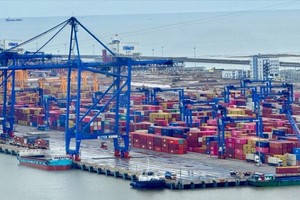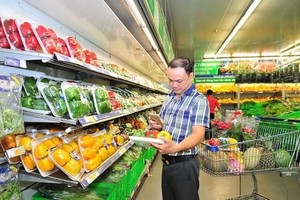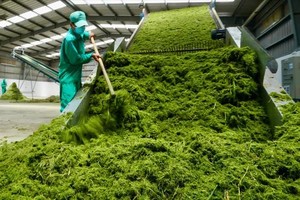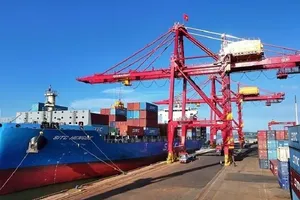Ms. Nguyen Thi Huong, Deputy Director of the General Statistics Office of Vietnam, said that seven out of 11 key commodity and services groups posted increases, of which, transportation saw the highest increase as the prices of petroleum products climbed for three consecutive times after a long losing streak since the Lunar New Year and the prices of pork continued to escalate in early-June.
However, the CPI in June still declined by 0.59 percent compared to December last year.
The CPI in the second quarter of this year fell 1.87 percent compared to the previous quarter and surged 2.83 percent compared to the same period last year. In the first six months of this year, the average CPI jumped 4.19 percent over the same period last year. This is the highest level in the period from 2016 to 2020.
The average commodity terms of trade in the first six months of this year decreased by 0.78 percent over the same period last year, showing that the unfavorable export prices of Vietnam's goods to foreign countries compared with the prices of goods imported from foreign countries to Vietnam. The average core inflation in the first six months of this year increased by 2.81 percent compared to the same period last year.
The gross domestic product (GDP) in the first six months rose 1.81 percent year-on-year, the lowest level in the period from 2011 to 2020. In the second quarter of this year alone, GDP is estimated to inched up by 0.36 percent.
In the economic growth of 1.81 percent in the first six months of Vietnam’s economy, the agro-forestry-fisheries sector augmented 1.19 percent, contributing 11.89 percent to the general growth; industrial and construction sector advanced 2.98 percent, contributing 73.14 percent; service sector shot up 0.57 percent, contributing 14.97 percent. The main motivation for the economic growth in the first six months of this year was industrial processing and manufacturing which emerged 4.96 percent and market services. Of which, wholesale and retail mounted 4.3 percent; finance, banking, and insurance activities rocketed 6.78 percent.
As for economic structure in the first six months of this year, the agro-forestry-fisheries sector accounted for 14.16 percent; industrial and construction sector 33.44 percent; services 42.04 percent.
Regarding the use of GDP in the first six months of this year, final consumption increased by 0.69 percent over the same period last year; accumulated assets gained 1.93 percent; exports of goods and services decreased by 0.31 percent; imports of goods and services slid by 2.54 percent.
The country’s socio-economic situation in the first six months of this year occurred in the context of an acute respiratory infection caused by a new strain of Coronavirus (Covid-19), a worldwide outbreak that seriously affected all economic and social aspects of countries in the world.
However, the CPI in June still declined by 0.59 percent compared to December last year.
The CPI in the second quarter of this year fell 1.87 percent compared to the previous quarter and surged 2.83 percent compared to the same period last year. In the first six months of this year, the average CPI jumped 4.19 percent over the same period last year. This is the highest level in the period from 2016 to 2020.
The average commodity terms of trade in the first six months of this year decreased by 0.78 percent over the same period last year, showing that the unfavorable export prices of Vietnam's goods to foreign countries compared with the prices of goods imported from foreign countries to Vietnam. The average core inflation in the first six months of this year increased by 2.81 percent compared to the same period last year.
The gross domestic product (GDP) in the first six months rose 1.81 percent year-on-year, the lowest level in the period from 2011 to 2020. In the second quarter of this year alone, GDP is estimated to inched up by 0.36 percent.
In the economic growth of 1.81 percent in the first six months of Vietnam’s economy, the agro-forestry-fisheries sector augmented 1.19 percent, contributing 11.89 percent to the general growth; industrial and construction sector advanced 2.98 percent, contributing 73.14 percent; service sector shot up 0.57 percent, contributing 14.97 percent. The main motivation for the economic growth in the first six months of this year was industrial processing and manufacturing which emerged 4.96 percent and market services. Of which, wholesale and retail mounted 4.3 percent; finance, banking, and insurance activities rocketed 6.78 percent.
As for economic structure in the first six months of this year, the agro-forestry-fisheries sector accounted for 14.16 percent; industrial and construction sector 33.44 percent; services 42.04 percent.
Regarding the use of GDP in the first six months of this year, final consumption increased by 0.69 percent over the same period last year; accumulated assets gained 1.93 percent; exports of goods and services decreased by 0.31 percent; imports of goods and services slid by 2.54 percent.
The country’s socio-economic situation in the first six months of this year occurred in the context of an acute respiratory infection caused by a new strain of Coronavirus (Covid-19), a worldwide outbreak that seriously affected all economic and social aspects of countries in the world.
























